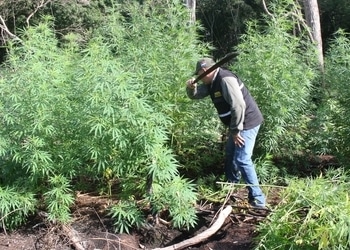Paraguay’s level of deforestation is outpacing some of its much larger neighbors – especially in the destruction of protected land.
At least 5,000 hectares of federally protected land in national parks have been destroyed by illegal deforestation in the past two years, Cristina Goralewski, president of the National Forest Institute (Instituto Forestal Nacional – Infona), told Paraguayan media.
This figure highlights the ongoing deterioration of Paraguay’s forest cover. Paraguay lost over 100,000 hectares of primary forests and a massive 6.28 million hectares of tree cover between 2001 and 2019, over a quarter of its total forests, according to data from Global Forest Watch.
This has made Paraguay the country with the second-highest rate of deforestation in Latin America since 2000, behind only Brazil, which has lost 26.7 million hectares of forest and nearly 60 million hectares of tree cover.
This deforestation often has similar causes as other regional countries, including illegally burning trees to clear land for cattle ranching. But another cause has become a significant contributor.
SEE ALSO: Corrupt Police in Paraguay See Opportunity in Illegal Logging
There is a significant overlap between illegal marijuana plantations and Paraguay’s protected areas. At least 2,350 hectares of marijuana plantations exist in Paraguay’s Paraná Atlantic Forest, especially in natural parks of Mbaracayú, San Rafael, Morombí and Caazapá, according to Mongabay.
Paraguay is the leading producer of marijuana in Latin America, and that impact has devastated its forests. In October 2020 alone, the country saw over 5,000 deliberate forest fires, which the government blamed on “agricultural reasons or to grow marijuana.”
Since at least 2016, marijuana has been the leading cause of deforestation in Paraguay, above clearing land for cattle and soybeans.
InSight Crime Analysis
Paraguay’s Atlantic rainforest in Alto Paraná, a collection of the Caazapá, Mbaracayú, Morombí and San Rafael territories, has been the number one target for drug traffickers to hide their marijuana crops, Mongabay reports.
Measuring 4.3 million hectares in 1994, the Atlantic rainforest now only stands at 2.7 million hectares, largely because of marijuana cultivation.
In a futile effort to stop this rapid deforestation, the Paraguayan government has worked with the forest’s park rangers to seize as much marijuana as possible. From 2015 to 2020, the National Anti-Drug Secretariat (Secretaría Nacional Antidrogas – SENAD) reported almost 82 tons worth of marijuana seizures from the Atlantic rainforest.
Unfortunately, the figures are trending in the wrong direction, with 40 percent of these seizures coming in 2020 alone.
SEE ALSO: Paraguay Grapples With Ever Larger Seizures of Marijuana
The use of protected natural areas to grow illicit crops is also a growing regional problem.
In Colombia, some of the country’s most dangerous criminal groups have set up bases inside natural parks. This means that, while Colombia’s total hectares of coca have dipped in recent years, the amount in protected areas has trended upwards. In 2020, the natural parks of Catatumbo Bari and La Paya saw coca cultivations increase by 66 and 49 percent, respectively.
Park rangers, often the only government presence inside national parks, have also come under increasing threat. In 2018, two park rangers were killed in Paraguay’s Tapytá natural reserve. Similar killings have recently taken place in Colombia, Costa Rica and Mexico, often when the rangers ran afoul of drug traffickers.

